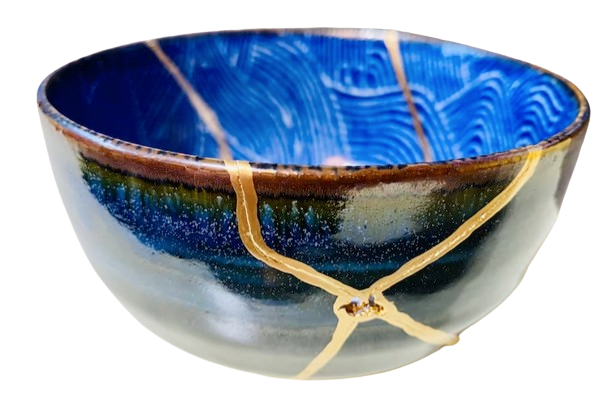All my problems are meaningless,
But that don’t make them go away.
– Neil Young, “On the Beach”
There is a crack in everything.
That’s how the light gets in.
– Leonard Cohen, “Anthem”
Every story is about being broken and trying to become whole.
All of us, even the happy ones among us, are in some way broken. At some point, usually early in life, we have experienced a moment of cracking and breaking. The breaking continues throughout our lives.
Start with the iconic heroes of literature: Oedipus, Odysseus, Lear, Macbeth. Gatsby (Scott Fitzgerald’s The Great Gatsby), Jake Barnes (Papa Hemingway’s For Whom the Bell Tolls), Yossarian (Joseph Heller’s Catch 22), Holden Caulfield (J.D. Salinger’s Catcher in the Rye), Sethe (Toni Morrison’s Beloved). More recently: Camille Preake (Gillian Flynn’s Sharp Objects), Rachel Watson (Paula Hawkins’s The Girl on the Train), or Harry Potter (the series by J.K. Rowling).
 The exception proves the rule: Socrates, who surrenders his life in Plato’s dialogues, struggles not with his own brokenness but with the brokenness of the Greek political elites. “You’ve acted as you have now because you think it’ll let you off being challenged for an account of your life,” he tells his prosecutors. “In fact, I tell you, you’ll find the case quite the opposite. There’ll be more, not fewer, people challenging you.” In other words: Your fake wholeness cannot hide your real brokenness.
The exception proves the rule: Socrates, who surrenders his life in Plato’s dialogues, struggles not with his own brokenness but with the brokenness of the Greek political elites. “You’ve acted as you have now because you think it’ll let you off being challenged for an account of your life,” he tells his prosecutors. “In fact, I tell you, you’ll find the case quite the opposite. There’ll be more, not fewer, people challenging you.” In other words: Your fake wholeness cannot hide your real brokenness.
How about modern American politics? So: presidents? Oh, god yes. JFK, LBJ, Nixon, Reagan, Clinton, Bush, Obama, Trump, Biden? Broken, everyone one of them.
We are all broken in many ways, actually. The challenge for the storyteller is to find the defining brokenness of the characters and to figure out how it compels their actions. Once we understand this primary brokenness, we can understand all the broken ways that we try to survive, day by day, and pursue our goals.
The story is about how we struggle to become whole. Some of our strategies are conscious, others less so. Some are more effective, others less so.
Unconscious Strategies to Fix What’s Broken
A character’s unconscious strategies come from our deepest, most repressed selves. This repression comes from experiences and emotions that are too hot to handle. In youth, they could have been abused of neglected. Either way, their development is stunted by the need to survive their early traumas. Their story, then, is about trying to handle things that are (at first) too hot to handle.
Think of those strategies: Money. Fame. Career. Service. Security. Popularity. Power. Love. Respect. Knowledge. Religion. Fear. Friendship. Boosterism. Do-gooderism and caretaking. Civic leadership. Booze, drugs, porn, and other external addictions.
These are all adaptations. With the exception of addictions, each one of them has positive aspects. They help the character survive to face another day. But the are, at best, incomplete adaptations—and ultimately fail to achieve wholeness.
Most of these strategies don’t work because they only address a part of the brokenness—and that, badly. In doing so, they actually repress the other parts of the brokenness, even more intensely. Success with the strategy, like making a lot of money, serves to intensify the pain.
A Larger Brokenness
Here’s the hardest part: Not only is the character broken–so is the society. Gabor Maté has written about “the myth of normal.” We are raised to think that society is “normal,” that is, functional and fair. But it’s not. It’s a hot mess of trauma: inequality, abuse, ill health, neglect, blame and self-blame, addiction, distraction. When we accept the values of modern society, we set ourselves up for a fall.
Maté lists a number of basic needs:
- Belonging, relatedness, or connectedness.
- Autonomy: a sense of control in one’s life; – mastery or competence.
- Genuine self-esteem, not dependent on achievement, attainment, acquisition, or valuation by others.
- Trust: a sense of having the personal and social resources needed to sustain one through life.
- Purpose, meaning, transcendence: knowing oneself as part of something larger than isolated, self-centered concerns, whether that something is overtly spiritual or simply universal/humanistic, or, given our evolutionary origins, Nature.
The story lies in the struggle to realize some of these needs in the face of an often-brutal or indifferent environment.
What Does Success Look Like?
So what does success look like, for the hero and other story characters? Think of the Japanese tradition of kintsugi, also known as kintsukuroi. It means repairing broken pottery by filling the cracks and gaps with lacquer.
The result is not perfect; it is better than perfect. In the Japanese philosophy of mushin, the imperfections symbolize the importance of non-attachment and acceptance of change. They also symbolize the the hard work we do to achieve this wisdom.



